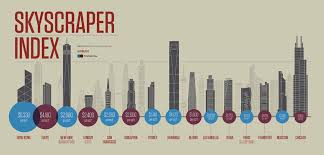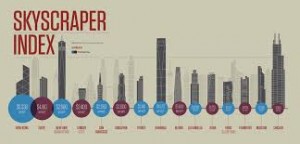Skyscraper Index is a concept put forward by Andrew Lawrence, in January 1999, which showed that the world’s tallest buildings have risen right before economic downturns. Business cycles and skyscraper construction correlate in such a way that investment in skyscrapers peaks when cyclical growth is exhausted and the economy is ready for recession. The buildings may actually be completed after the onset of the recession.
Some of the examples are listed below:
The world’s first skyscraper, New York’s Equitable Life building, 166 metres, was finished in 1873 during a five-year recession from 1873-1878.
The Singer Building, 187 meters tall, and Metropolitan Life Insurance Company Tower, 247 meters, were launched in New York before the panic of 1907 in 1908 and 1909, respectively. Met Life remained the world’s tallest building until 1913.
Empire State Building, 443 meters tall, was launched in 1931, shortly before the Wall Street Crash of 1929. Chrysler building, 319 meters, opened to the public in 1929 as well.
The World Trade Centre towers (541 m) and Sears Tower (442 m), opened up in 1973, during the 1973–1974 stock market crash and the 1973 oil crisis. Petronas Twin Towers, 452 m high, opened up in the wake of the 1997 Asian Financial Crisis and held the world height record for five years.
Taipei 101, 449 meters high, opened in 2004, after the dot com bubble of 2000-2003
Burj Khalifa, 828 meters high, opened in 2008, in the middle of The Great Recession of 2007-2009.
Click here for government certifications





19 Comments. Leave new
Informative article. 🙂
Thanks Kriti !
Good work…
Thanks Padmaa !
A good read 🙂 Nice choice of topic
Thanks Anusha!
Good one. Can you throw some light on what is the reason for this correlation?
The Skyscraper Index reflects the booms and busts of asset bubbles in cities across the world. An asset bubble occurs when there is excess demand, enthused primarily by low interest rates, until there is market correction to fix the over-inflated prices. Building skyscrapers is a very capital intensive activity. Skyscrapers are built on top of high land prices and have the additional costs of interior modifications value. The relatively high cost of building a skyscraper is only possible with access to financing, especially during periods of low interest rates. Lower interest rates are conducive to building as high as possible. Given the lag in construction, a record breaking building would come on-line during the period of output declines. Thus, there will be an observed positive correlation between recessions and records.
Nice facts
Thanks Alisha !
informative
Thanks Rahull !
Unique choice of topic…very informative!
very well written Mitra 🙂
Nicely written. But can you just explain the reason for such correlation?
Unique concept and well explained too!!
Nice 😀
well written
Informative!